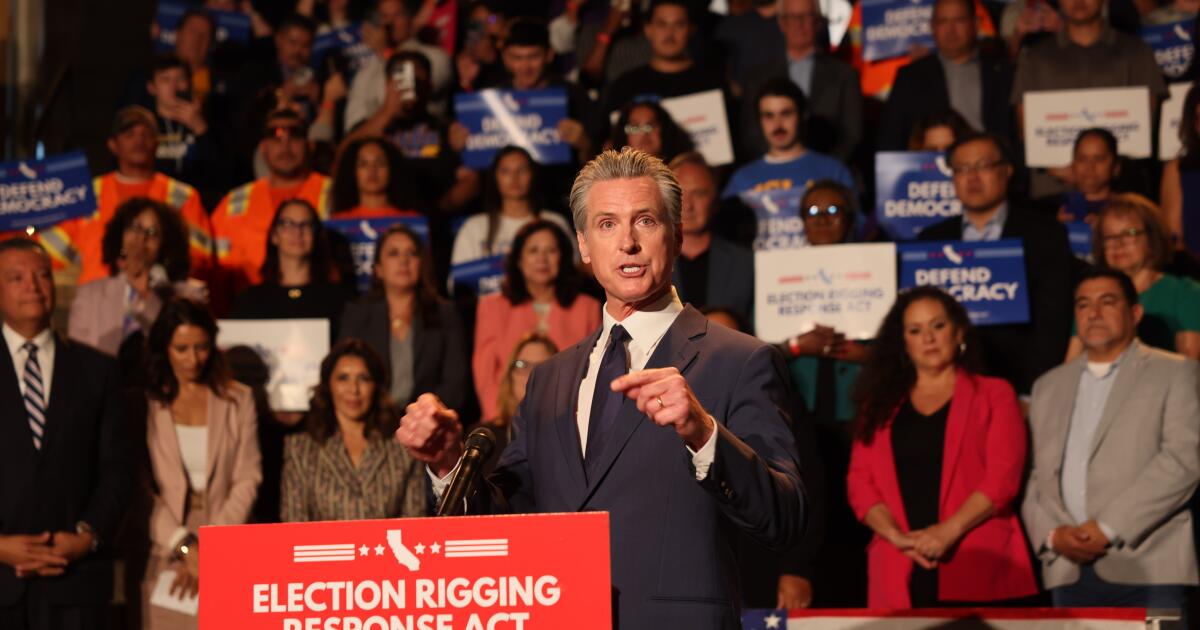California redistricting ploy is a long-term Democratic loser
Today we discuss flora, fauna and self-gratification.
You’ve been away.
Yes, I was living in a tent for two weeks, communing with the pine trees and black bears of the Sierra.
You heard about California’s likely special election?
I did.
It seems Gov. Gavin Newsom will have his way, with help from the Democratic-run Legislature, and voters will be asked in November to approve a partisan gerrymander aimed at offsetting a similar Republican power grab in Texas.
As many as five GOP House seats could be erased from the congressional map drawn by California’s independent redistricting commission, which voters established more than a decade ago — expressly to take the line-drawing away from a bunch of self-interested politicians.
Fighting fire with fire!
Could we please retire that phrase.
Huh?
Also references to knife fights and Democrats showing up with pencils, rubber bands, butter knives and other wimpy implements. The campaign hasn’t even started and already those metaphors have grown stale.
Fine. At least Democrats are showing some fight.
In an impulsive, shortsighted fashion.
Look, I get it. Donald Trump truly knows no bottom when it comes to undermining democratic norms, running a familial kleptocracy and, in the felicitous phrase of Gustavo Arellano, my fellow Times columnista, treating the Constitution like a pee pad.
Democrats are powerless in Washington, where a pliant Republican-controlled Congress and a supine right-wing Supreme Court have shown all the deference of a maître d’ squiring Trump to his favorite table. So the idea of doing something to push back against the president is quite invigorating and, no doubt, gratifying for Democratic partisans.
It’s also expedient and facile, sparing the party from looking inward and doing the truly hard work it faces. Taking on Republicans over redistricting — a fight among insiders, as far as many voters are concerned — does absolutely nothing to address the larger problem confronting Democrats, which is the absence of any broader message beyond: Trump, bad!
We saw how that worked for them in 2024.
But this is a “break-the-glass” moment for our democracy. Gov. Newsom said so!
Please.
The only thing worse than a grasping and nakedly calculating politician is a politician who wraps his grasping and naked calculation in all sorts of red, white and blue bunting.
At bottom, this is all about Newsom’s overweening presidential ambitions.
How so?
The whole episode started when our gallivanting governor went on a left-wing podcast during a Southern campaign swing and huffed and puffed about responding to Trump and Texas by executing a similar gerrymander in California. (He elided the fact that, under the state Constitution, he has no such authority. Hence the need for a special election to seek voter approval of new, slanted political lines.)
Soon enough, Newsom’s threat took on a life of its own. Normally, redistricting is done once every 10 years, after the latest census. Suddenly, mid-decade redistricting became a new front in the ever-escalating war between red and blue; now several more states are talking about rejiggering their congressional maps for partisan gain.
The problem for Newsom and his fellow Democrats is that Republicans have a lot more gerrymandering opportunities than they do. So instead of those five Democratic-held seats in Texas, many more could be at risk for the party in 2026.
Golly.
Though, it should be said, at this point all that election handicapping is nothing more than speculation.
What do you mean?
Democrats need to flip three congressional districts to seize control of the House. That’s why Trump prodded Texas Republicans to try to nab those five extra seats, to give the GOP some padding.
But there’s no guarantee Republicans will win all five seats. They’re counting on the same strong Latino support Trump received in 2024, and recent polling suggests some of that pro-GOP sentiment may be waning.
Beyond that, the ever-insightful Amy Walter, of the nonpartisan Cook Political Report, makes an important point.
“Even as the possibility of new maps in Texas and California may change the size and the shape of the 2026 playing field,” she wrote in a recent analysis, “the fate of the Republican-controlled House is ultimately still going to be determined by two fundamental questions: how do voters feel about the state of the economy, and how do independent voters assess the party in power?”
It’s a long way to November 2026. But at this point, neither of those factors augurs well for Trump and Republicans.
Well, they started it, by messing with Texas.
True. And none of this is meant to defend Trump, Texas Gov. Greg Abbott or the president’s other political henchmen.
But effectively disenfranchising millions of California Republicans isn’t any better than effectively disenfranchising millions of Texas Democrats.
Huh?
If Democrats have their way, the GOP would hold just a handful of California’s 52 House seats, or even less. How is that possibly fair, or representative, in a state that’s home to millions of Republican voters — more, in fact, than any state other than Texas.
There are already countless residents, many living outside Democrats’ city and suburban strongholds, who feel ignored and politically impotent. That’s not healthy for California, or democracy. It breeds anger, resentment, cynicism and a kind of political nihilism that, ultimately, helps lead to the election of a middle-finger president like Donald Trump.
Of course, Newsom may not care, since at this twilight point of his governorship it’s all about his White House hopes and desire to pander to the Democrats’ aggrieved political base.
By fighting fire with fire!
And potentially burning the whole place down.

